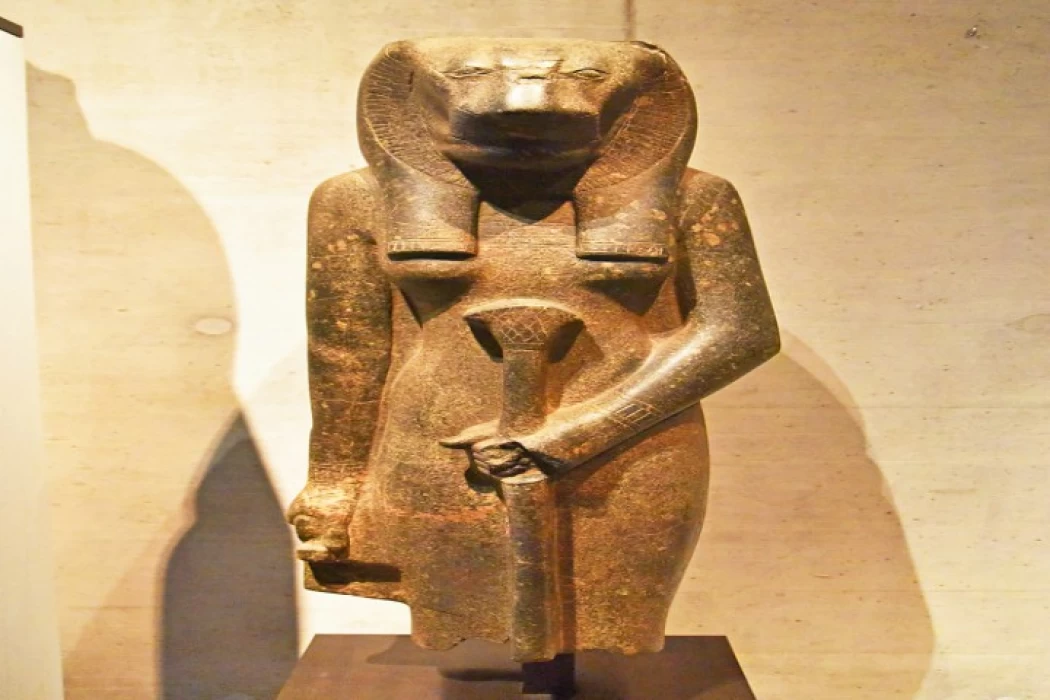
Goddess Sekhmet
Facts About Goddess Sekhmet
Sekhmet was not only the goddess of war and revenge for the ancient Egyptians, she was the goddess of doctors, and the mother who is associated with the lioness, so she defends her young with all her strength and gives them protection. Sekhmet was associated with soldiering and the military, and with the invincible land, as she was the lady of the two lands, “the Delta and Upper Egypt.” Therefore, the Egyptians preserved her image in folk tales as well, and they still do.
In ancient Egyptian beliefs, Sekhmet is the wife of the god Ptah, who created the world with a word from him. Ptah was the protector of craftsmen and artists, and he is the greatest god of Memphis. Her son is the god Nefertum, who resembles the lotus flower, as the goddess of treachery Sekhmet was surrounded by the goddess of thought, art and divinity Ptah. Her son was a symbol of perfume and the rising sun. He added that Sekhmet was placed on the war flag when the Egyptians fought their wars, as the poetic hymn of Ramses II in the Kadesh War says: He asked Amun to help him, so Amun gave him the strength of Sekhmet in his arm.
In ancient times, "Montu" was the god of war and his headquarters were in Armant, but based on the Egyptian myth that the gods sent her as a punishment to humans for their injustice, Sekhmet in modern times for the Egyptians took on the function of the goddess of war, as the statues of the powerful Sekhmet were placed in the form of a lioness sitting on a throne decorated with the symbol of the unification of North and South Egypt, and holding in her hand the key of life "Ankh", and on her head the sun disk and the cobra snake.
She was symbolized by symbols of war, desert and epidemics, as Sekhmet was not only resorted to in war; because she was just and vengeful in ancient Egyptian thought only, she was the goddess of doctors and healing; because medicine was associated with the Egyptians with healing from psychological conditions; therefore, King Amenhotep III, whom archaeologists describe today as "the Great Pasha" gave her a number of sculptures in an attempt to treat him.
Amenhotep III did not fight wars like his ancestors who built a vast empire; but he was like all Egyptians at that time who believed in Sekhmet and her power; so he made thousands of statues of her, confirming that Sekhmet still lives among us in the common dialects of Upper Egypt, where the word “askhmetak” means “I disfigure your face”, and her form, which the ancients put, was linked to the image of “our mother the ghoul” in the folk tales that grandmothers used to tell.
According to ancient Egyptian religion, Sekhmet is the daughter of Amun Ra, the god of the sun disk and the most important of the gods of ancient Egypt. This deity is depicted with a woman's body, a lioness's head, and a sun disk on top. This goddess always wore a long red robe, symbolizing her roots.
Furthermore, because she was so powerful and feared, she held great importance for King Amenhotep III, who ordered the construction of 365 statues to worship her and thus calm her anger.
On the other hand, she possessed protective and healing powers, primarily to heal human fractures, making her the patron saint of physicians. Sekhmet was known as the goddess of love, arousing passions, being the most beautiful of the Egyptian gods, and always splendid.
Furthermore, Sekhmet was known as the eye of her father, Ra, the sun god. Seeing that humans were rebelling and would no longer pay homage to her, he decided to send his daughter to pursue and destroy them. She unleashed her great anger and began to attack those who had turned their backs on her father. Her unstoppable anger was so great and merciless that even the god Amun Ra felt humanity's mercy and, therefore, decided to stop her, but failed.
The goddess Sekhmet was called “the devourer” because she played a role in the myth of the destruction of humanity. This was one of the most important myths in the history of Egyptian civilization, which tells the story of the god Ra, as she was the daughter of Ra and the eye of Ra, who sent her to destroy his enemies.
She took the form of a female lion and destroyed these human enemies, However, she continued to destroy even the innocent later on, to the extent that the god Ra wanted her to stop, so he carried out a certain trick to prevent her from continuing to destroy all humans.
The name Sekhmet comes from the ancient Egyptian word s, m, which means “strength or power”. The ancient Egyptian name for Sekhmet translates to “(strong or mighty person).”
Moreover, the goddess was also given titles such as “(one) before the one who trembles evil” “Lady of Dread”. In addition, the titles “Lady of Slaughter” and “She Moles” also refer to Sekhmet.
She is the wife of the god "Ptah" in the "Menf" trinity (Ptah; Sekhmet; Nefertum). She is the goddess of oppression in ancient Egypt, the daughter of the god "Ra", and his eye that attacks hostile forces; She is one of the most important goddesses who embodies the eye of the sun god "Ra".














